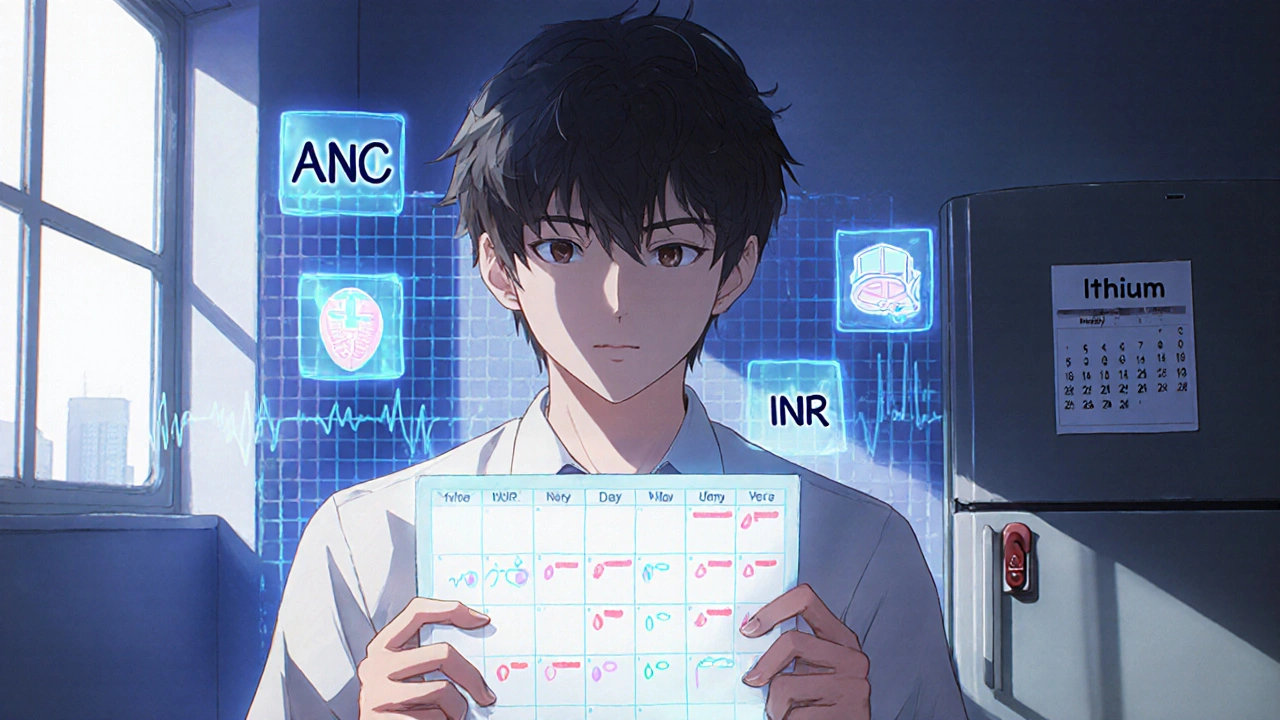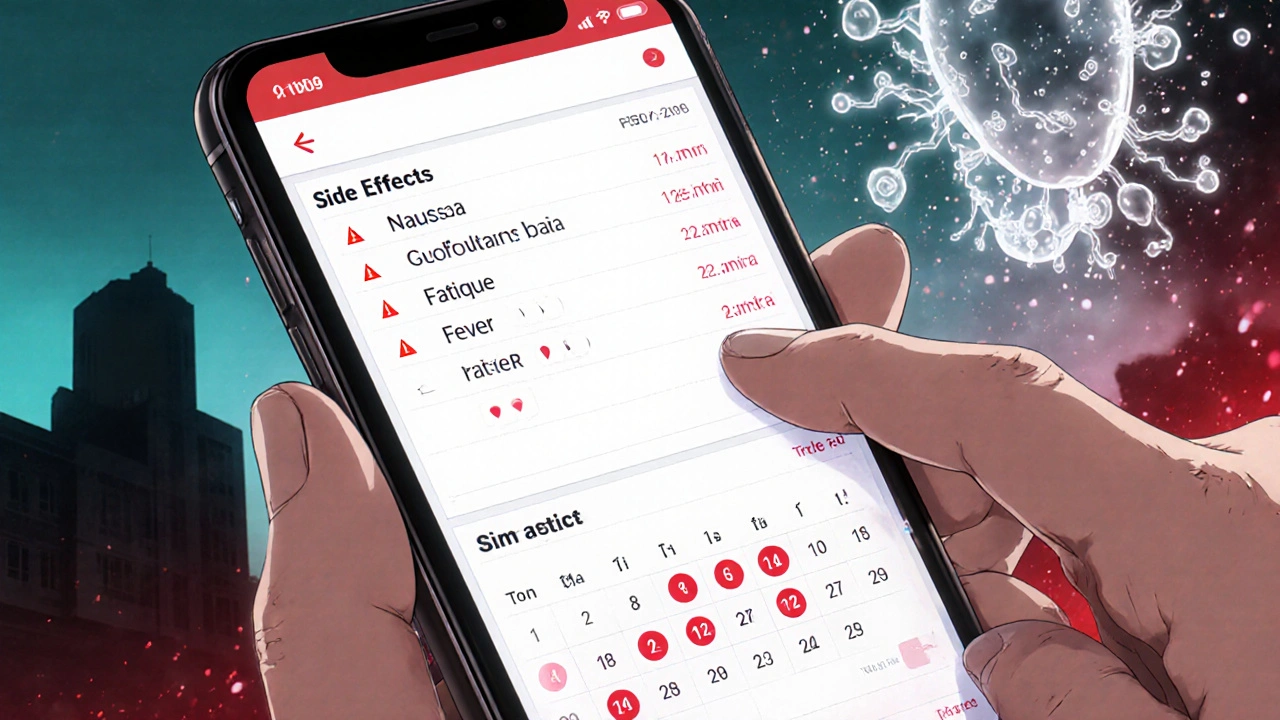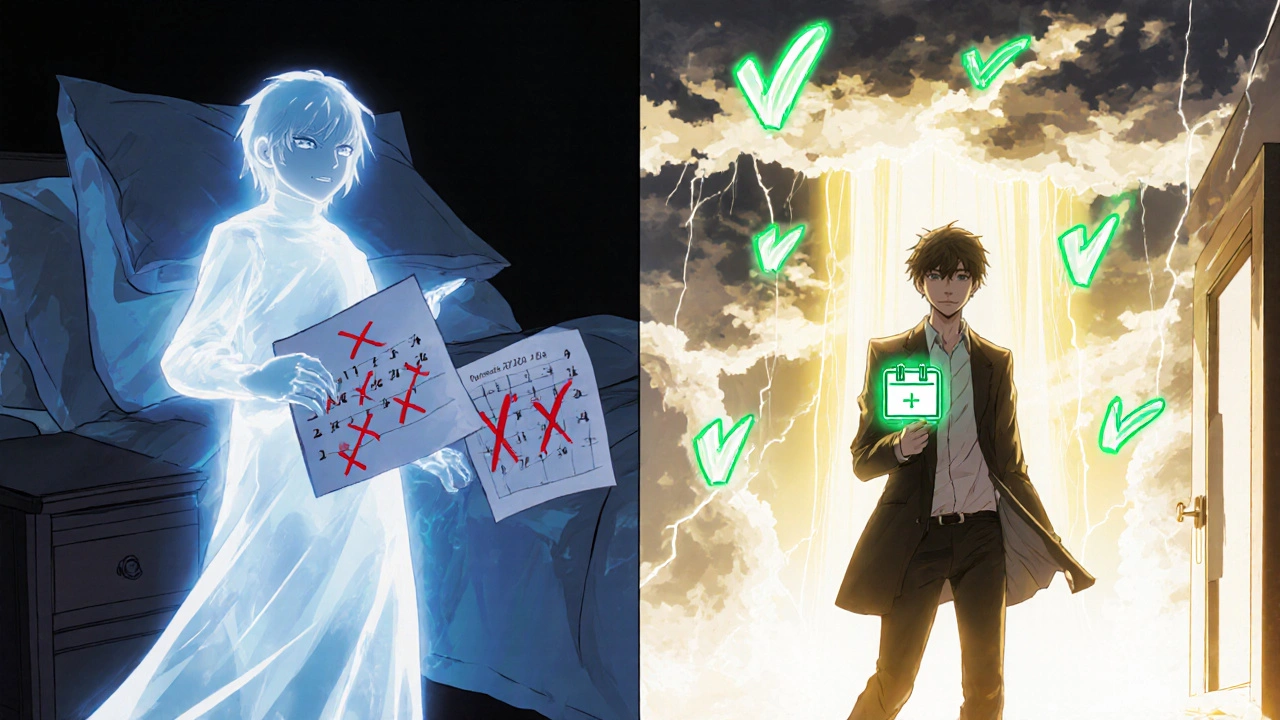Lab Monitoring Calendars: Stay Ahead of Medication Side Effects

When you start a new medication, especially one with serious side effects, the real work doesn’t begin when you take the first pill-it begins with lab monitoring calendars. These aren’t just reminders to get blood drawn. They’re your early warning system. Miss a test, skip a check-in, and you could be walking into a preventable crisis-low white blood cells, kidney damage, liver stress, or worse. The good news? With a simple, personalized calendar, you can stay one step ahead.
Why Lab Monitoring Isn’t Optional
Some medications are like fine-tuned engines. Too little, and they don’t work. Too much, and they break something inside you. Lithium for bipolar disorder, clozapine for treatment-resistant schizophrenia, warfarin for blood clots-these drugs have narrow safety margins. That means your body’s response has to be tracked closely, not guessed at.Take clozapine. It’s powerful for severe psychosis, but it can crash your white blood cell count. If your ANC (absolute neutrophil count) drops below 500/μL, you’re at serious risk of infection. The rules are strict: weekly blood tests for the first four weeks after your ANC hits 1500/μL, then monthly after that-for life. No exceptions. Skip one test, and you could miss the warning sign before it’s too late.
Same with lithium. Too high, and you get tremors, confusion, even seizures. Too low, and your mood swings return. Doctors check your lithium level 5 to 7 days after starting it, then weekly until it stabilizes. After that? At least every six months. But if you change doses, get sick, or start a new drug, you need another test-fast.
What Gets Monitored and When
Not all meds need the same tests. Your calendar depends on what you’re taking.- Clozapine: ANC every week (early phase), then monthly. Watch for fever, sore throat, fatigue-signs your immune system is dropping.
- Lithium: Serum level every 6 months (stable), plus kidney and thyroid tests annually. Check more often if you’re dehydrated or on diuretics.
- Warfarin: INR every 4 weeks, but bump it to weekly during dose changes or if you start antibiotics or change your diet (especially leafy greens).
- Antibiotics like linezolid: Platelet count every 2 weeks after 2 weeks of use-risk of low platelets rises over time.
- Corticosteroids (over 2 weeks): Morning cortisol test if you’ve been on it long-term. Suddenly stopping can cause adrenal crash.
- Glaucoma drops (dorzolamide/timolol): Annual eye exams to check pressure and nerve damage.
- LONSURF (cancer chemo): Weekly blood counts, plus daily logs of diarrhea, nausea, fatigue. Dose delays happen fast if counts drop.
Some meds need minimal tracking. Mirtazapine? Just watch your appetite and weight for the first 4 to 8 weeks. If you gain 5% of your body weight, talk to your doctor. No blood test needed.
Digital vs. Paper Calendars: Which Works for You?
You’ve got options. The right one depends on how you live.Printable templates (like those from Community Behavioral Health or CBH Philly) are simple. Print one, stick it on your fridge, check off tests with a pen. Great for people who don’t want tech. But if your dose changes, you have to print a new one. And if you forget to bring it to your appointment? You’re back to square one.
Digital apps like Blood Cancer United’s Health Manager let you log side effects in real time-headache, nausea, dizziness-and link them to your meds and meals. The app shows patterns: “Your nausea spiked every time you took LONSURF after a high-fat breakfast.” That’s gold. It syncs with your calendar, sends reminders, and can email your doctor a summary before your visit.
Ulta Lab Tests lets you order your own blood work without a doctor’s order-but you still need a provider to interpret it. No scheduling. No side effect tracking. Just a list of tests. Useful if you’re self-advocating, but not a full system.
The best tools combine both: a calendar that auto-updates with your dose changes and lets you log symptoms. Some oncology centers now give patients custom LONSURF calendars generated online-dose-specific, with space to note temperature, missed pills, and bowel movements. These aren’t generic. They’re built for your exact regimen.

How to Build Your Own Lab Monitoring Calendar
Start with what you know:- List your meds and their monitoring rules. Ask your pharmacist or check the FDA label. Don’t guess.
- Find your key tests. What blood work, scans, or exams are required? Write them down with frequency: weekly, monthly, every 6 months.
- Mark your calendar. Use Google Calendar, Apple Health, or a physical planner. Set recurring reminders 2 days before each test. Don’t wait until the day before.
- Track side effects daily. Even if you don’t feel sick, note: energy level, appetite, sleep, mood, bowel habits. Small changes matter.
- Update it every time your dose changes. A new prescription? A dose increase? Print a new version or update your app immediately.
- Bring it to every appointment. Even if your doctor says they have your records, bring your own log. You’ve seen patterns they haven’t.
Example: You’re on clozapine. Your ANC was 1800 last month. You’re now in the monthly phase. Mark your calendar: “ANC draw: 15th of every month.” Set a reminder: “Call clinic to schedule 3 days before.” Log daily: “Fever? No. Sore throat? No. Fatigue? Mild.”
Common Mistakes That Put You at Risk
People skip tests for all sorts of reasons:- “I feel fine.” That’s exactly when things are quietly going wrong. Lithium toxicity doesn’t always make you dizzy-it makes you slow, confused, or forgetful. You might think it’s just aging.
- “I forgot.” Set two reminders. One on your phone. One on your kitchen wall. Use sticky notes if you have to.
- “The lab was closed.” Don’t wait. Call your doctor. They might have a mobile phlebotomy service or a partner clinic.
- “I didn’t bring my calendar.” Your doctor can’t help if they don’t know your history. Keep a digital copy on your phone. Take a photo of your paper one.
- “I stopped taking it.” If you quit your med, you still need to finish monitoring. Stopping lithium suddenly can cause rebound mania. Stopping warfarin without a plan can cause clots.

What Happens If You Miss a Test?
Don’t panic. But don’t ignore it either.If you miss a clozapine ANC test by a week, call your prescriber immediately. They might delay your next dose. If you miss a lithium level check for 3 months, get tested ASAP-your level could be dangerously high.
Some clinics will pause your prescription until you’re caught up. That’s not punishment-it’s safety. You wouldn’t drive a car without checking the oil. This is the same.
Worst-case scenario? A preventable hospitalization. Warfarin patients who skip INR checks are 3 times more likely to have a major bleed. Lithium patients who go too long without testing have higher rates of kidney damage. These aren’t rare. They’re routine-and avoidable.
Future of Lab Monitoring
The next wave is smarter tools. Apps are starting to connect with wearables-tracking your heart rate, sleep, and activity to flag early signs of toxicity. AI models are being trained to predict when your lab values might dip, based on your history, diet, and even weather patterns.But right now, the best tool is still simple: a calendar you update, a log you keep, and the discipline to show up for your tests-even when you feel fine.
Medication safety isn’t about being perfect. It’s about being consistent. One test missed can turn into a hospital stay. One calendar kept can keep you out of it.
Do I need a lab monitoring calendar if I feel fine?
Yes. Many dangerous side effects-like low white blood cells from clozapine or rising lithium levels-don’t cause obvious symptoms until they’re severe. Feeling fine doesn’t mean your labs are safe. Monitoring catches problems before you feel them.
Can I use a regular calendar app like Google Calendar?
Absolutely. Set recurring reminders for your lab tests and label them clearly: “Clozapine ANC Draw,” “Lithium Level Check.” Add notes like “Fast for 8 hours before” or “Call clinic if fever.” You can even attach photos of your printed logs. It’s not fancy, but it works.
What if my doctor doesn’t give me a calendar?
Ask for one. Most guidelines (like those from NIH or Community Behavioral Health) expect patients to track their own labs. If your provider doesn’t offer a template, download a printable version from reputable sources like Blood Cancer United or Ulta Lab Tests. Bring it to your next visit-it shows you’re proactive.
How often should I update my lab calendar?
Update it immediately after any change: new medication, dose increase or decrease, new side effect, or illness. Even if you’re just starting a vitamin or antibiotic, it could affect your lab results. Your calendar should always reflect your current treatment plan.
Can I order my own lab tests without a doctor?
Yes, through services like Ulta Lab Tests. But you still need a doctor to interpret the results. A low ANC or high lithium level means nothing without context. Don’t self-diagnose. Use the tests to start a conversation with your provider-not replace it.
What if I can’t afford the lab tests?
Talk to your pharmacy or clinic. Many offer sliding-scale fees or free monitoring programs for high-risk meds like clozapine or lithium. Some pharmaceutical companies provide free test kits for patients on their drugs. Don’t skip tests because of cost-ask for help first.






Comments
Will RD
October 30, 2025 AT 15:42Umm yeah so i just skipped my lithium test last month cause i felt fine and now my doc is mad lol
Theresa Ordonda
October 31, 2025 AT 17:51My calendar is color coded now 🌈 Red = ANC draw, Blue = Lithium, Green = "don't eat kale for 3 days". I even set alarms with emojis. 🚨💊
Jenni Waugh
November 1, 2025 AT 06:04It's 2024 and people still need to be told to track their labs like they're not a toddler with a new medication? 🤦♀️ This isn't rocket science. You don't skip oil changes on your car. Why would you skip blood tests on your body?
Ganesh Kamble
November 1, 2025 AT 15:09bro this whole thing is just corporate pharma gaslighting. who even needs all these tests? i’ve been on clozapine 7 years and my ANC is fine. just chill
Shana Labed
November 3, 2025 AT 05:24OMG I just started using the Blood Cancer United app and it’s a GAME CHANGER. It auto-logs my nausea when I swipe my meds and sends my doc a weekly report. I cried. I’ve never felt so seen. 🥹
Megan Raines
November 4, 2025 AT 06:15Wait so you’re telling me I can’t just wing it like I did with my Adderall in college? 🤨
chantall meyer
November 5, 2025 AT 01:29How quaint. A calendar. How 2019. I use a blockchain ledger synced to my smart fridge. My lithium level triggers a cold brew dispenser. You’re all still using paper? How… rustic.
Judy Schumacher
November 7, 2025 AT 01:24Let’s be honest: the entire system is designed to make patients feel like fragile, incompetent children. You don’t need a calendar. You need autonomy. But of course, the medical-industrial complex prefers compliance over competence.
Mamadou Seck
November 7, 2025 AT 14:04Why even bother with all this if your doc is just gonna ignore your logs anyway? I printed mine 12 times. They never looked at it. Just nodded and wrote me a new script
Wayne Keller
November 8, 2025 AT 00:32Just set a recurring reminder on your phone. Name it "Don’t Die Because You Forgot". Simple. No apps. No fancy charts. Just do it.
Anthony Griek
November 9, 2025 AT 06:36I’ve been on warfarin for 12 years. I do my INR every 4 weeks like clockwork. I don’t need an app. I don’t need a calendar. I just remember. Maybe we should stop making this so complicated.
Norman Rexford
November 11, 2025 AT 00:06Look I get it but this whole thing feels like America trying to micromanage our health. In my country we just take the pill and trust God. No calendars. No apps. Just faith and a strong constitution.
California Daughter
November 12, 2025 AT 11:48...but what if you just... forget? Like, on purpose? 😏
Vishwajeet Gade
November 13, 2025 AT 00:25Bro you really think your ANC is gonna drop overnight? Nah. I’ve been skipping mine since 2020 and I’m still alive. You’re all paranoid
Jacqueline Anwar
November 14, 2025 AT 16:27It’s not about being perfect. It’s about being responsible. I’ve seen three people hospitalized because they "felt fine." One of them died. This isn’t a suggestion. It’s a lifeline. If you’re skipping tests, you’re gambling with your life - and you’re not even good at poker.